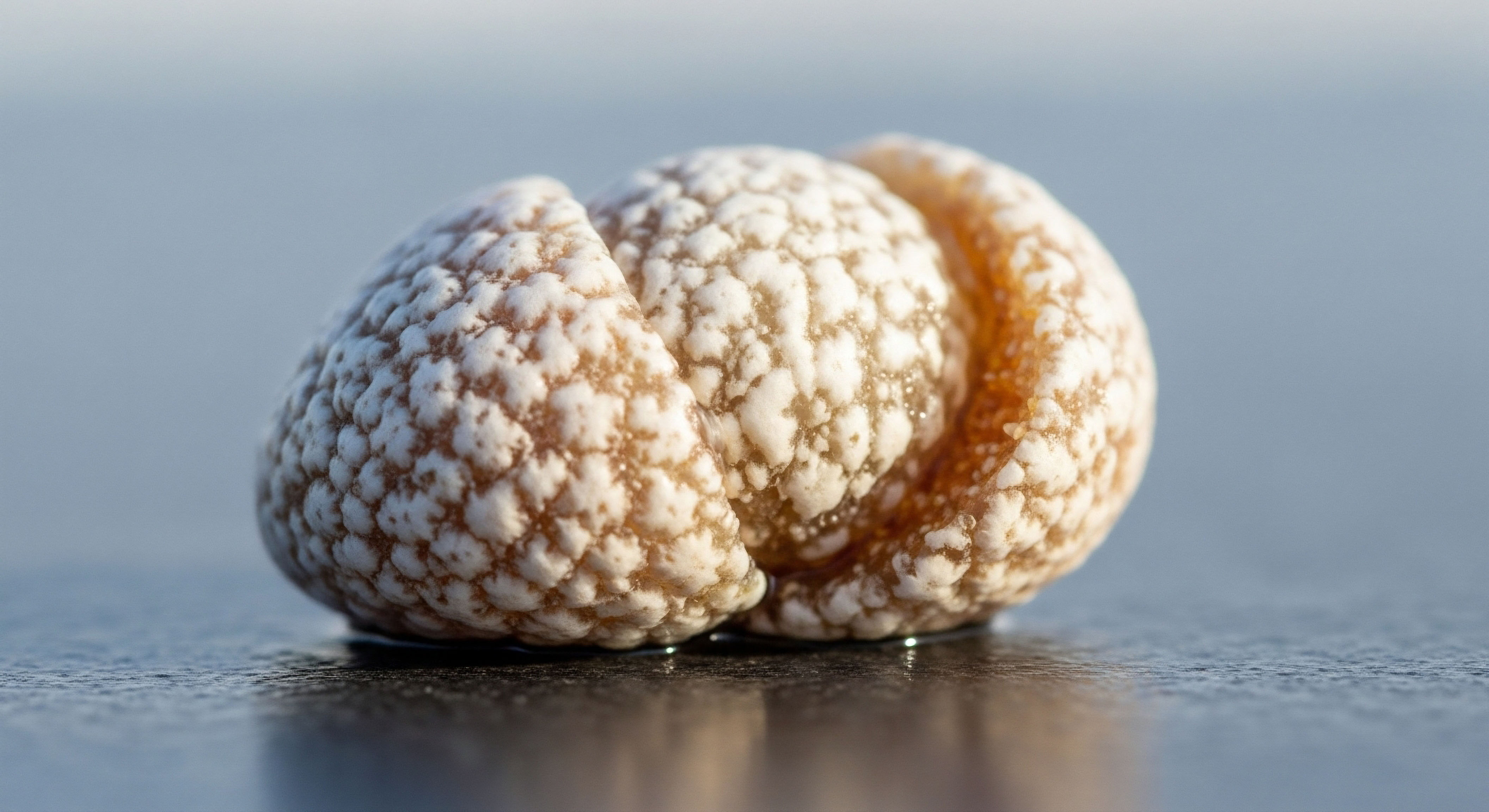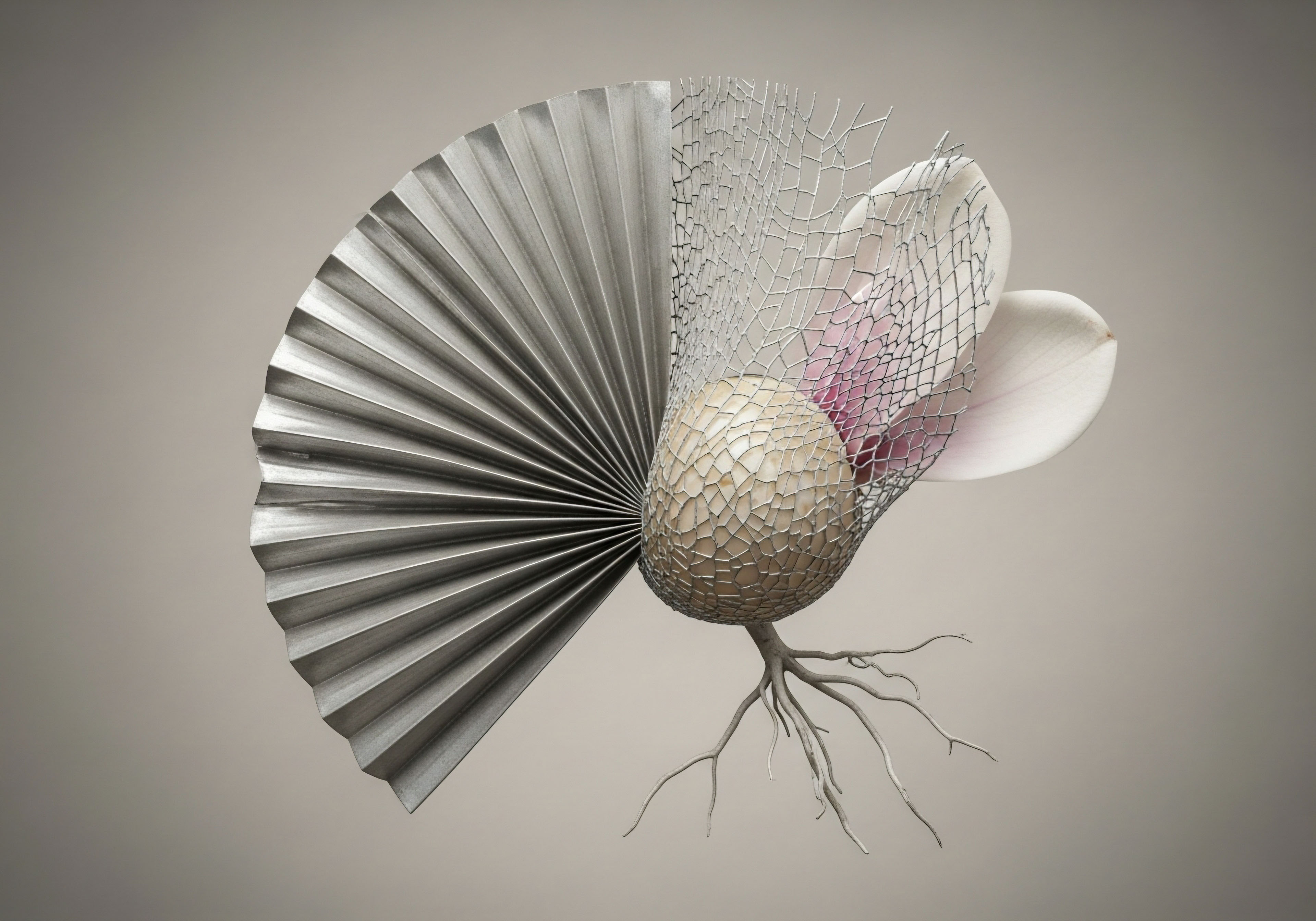

Fundamentals
The decision to manage your own hormonal environment often begins with a desire for vitality, a drive to function at your peak. You took action based on a perceived need, and in doing so, you learned a fundamental principle of physiology firsthand ∞ the body is a responsive, interconnected system.
The question you are asking now, about restoring fertility, comes from a place of deeper understanding. It acknowledges that every input has a corresponding systemic output. The concern is valid, and the biological processes behind it are clear. Restoring your body’s natural hormonal rhythm is a journey of recalibration, moving from external support back to internal production.
Your body’s endocrine system operates on a sophisticated series of feedback loops, much like a high-tech thermostat regulating a complex climate-control system. The central command for your reproductive and hormonal health is the Hypothalamic-Pituitary-Gonadal (HPG) axis. This axis is a continuous conversation between three key components.
- The Hypothalamus This is the sensor in your brain. It detects the body’s need for testosterone and releases a signaling molecule called Gonadotropin-Releasing Hormone (GnRH).
- The Pituitary Gland Receiving the GnRH signal, this master gland releases two more messengers into the bloodstream ∞ Luteinizing Hormone (LH) and Follicle-Stimulating Hormone (FSH).
- The Gonads (Testes) These are the final target. LH instructs the Leydig cells in the testes to produce testosterone. Simultaneously, FSH, along with testosterone, tells the Sertoli cells to initiate and maintain sperm production, or spermatogenesis.
When you introduce testosterone from an external source, the hypothalamus senses that testosterone levels are high. Its logical response is to stop sending GnRH signals. The pituitary, no longer receiving GnRH, ceases its release of LH and FSH. Consequently, the testes, deprived of their instructions, halt both testosterone synthesis and sperm production.
This state is known as exogenous hypogonadism. It is the body’s intelligent, adaptive response to an abundance of externally supplied hormone. The challenge, and the focus of restoration, is convincing this system to turn itself back on.
Prolonged use of external testosterone suppresses the body’s natural hormonal signaling axis, leading to a temporary shutdown of sperm and testosterone production.

The Biological Consequence of Suppression
The shutdown of the HPG axis is a predictable and direct outcome. Without the constant stimulating signals of LH and FSH, the testicular machinery responsible for fertility goes dormant. The Leydig cells are no longer called upon to produce testosterone, and the Sertoli cells lack the necessary FSH signal to support developing sperm cells.
This leads to a significant reduction in sperm count (oligospermia) or a complete absence of sperm in the ejaculate (azoospermia). It can also result in a noticeable decrease in testicular volume, a physical manifestation of the system’s dormancy.
Understanding this mechanism is the first step toward reversing it. The body has not forgotten how to function; its communication lines have simply been paused. The goal of any fertility restoration protocol is to systematically and safely re-establish that internal dialogue, encouraging the brain to resume its role as the master regulator of your hormonal health.


Intermediate
Reawakening the body’s innate hormonal production after a period of external testosterone use is a process of strategic intervention. The core objective is to overcome the suppressive feedback that the external hormones created. We must prompt the hypothalamus and pituitary to resume their signaling duties.
The protocols designed for this purpose are not a single solution but a combination of therapies tailored to stimulate the HPG axis at different points in its cascade. This is a delicate biochemical negotiation with the body, aimed at restoring its natural operational state.

Protocols for HPG Axis Reactivation
A post-TRT or fertility-stimulating protocol is built around medications that mimic or stimulate the body’s own hormonal signals. These interventions are designed to restart the conversation between the brain and the testes. The primary agents used in these protocols work through distinct yet complementary mechanisms.

Direct Testicular Stimulation
One of the most direct methods to restart testicular function involves using agents that act like LH. Gonadorelin, a synthetic form of GnRH, or human chorionic gonadotropin (hCG), a hormone that is structurally similar to LH, can be used. When administered, these compounds bind to the LH receptors on the Leydig cells in the testes.
This provides the direct signal to produce testosterone and helps increase intratesticular testosterone levels, a key requirement for spermatogenesis. This approach essentially bypasses the dormant pituitary and gives the testes a powerful “wake-up” call, preparing them for the resumption of the body’s own signals.

Re-Engaging the Brain’s Signal
The second part of the strategy focuses on the brain. Selective Estrogen Receptor Modulators (SERMs) like Clomiphene Citrate (Clomid) and Tamoxifen Citrate are central to this process. Testosterone is converted into estrogen in the body, and both hormones signal the hypothalamus to halt GnRH production.
SERMs work by blocking the estrogen receptors in the hypothalamus. The brain, perceiving low estrogen activity, is prompted to increase its output of GnRH. This, in turn, stimulates the pituitary to release more LH and FSH, re-establishing the entire signaling cascade from the top down. It is a sophisticated way of recalibrating the body’s hormonal sensor.
Clinical protocols restart fertility by using specific medications to directly stimulate the testes while simultaneously signaling the brain to resume its natural hormone production.

What Factors Influence Recovery Time?
The timeline for restoring fertility is highly individual. It is influenced by a number of variables related to both the duration of testosterone use and a person’s underlying physiology. While many individuals see a return of spermatogenesis within several months, for others it can take a year or longer. Some may face significant challenges in achieving full recovery. Understanding these factors is essential for setting realistic expectations.
| Factor | Impact on Recovery |
|---|---|
| Duration of Use |
Longer periods of testosterone administration typically lead to more profound suppression of the HPG axis, often requiring a longer recovery period. The system becomes more accustomed to the dormant state. |
| Dosage and Compounds |
Higher doses and the use of more suppressive anabolic compounds can deepen the shutdown of natural signaling, complicating and extending the restoration process. |
| Pre-existing Testicular Function |
An individual’s baseline testicular health and fertility status before starting testosterone is a critical determinant. A more robust system will generally recover more quickly. |
| Age |
Younger individuals often exhibit a more resilient and responsive HPG axis, which may contribute to a faster recovery compared to older individuals. |
| Adherence to Protocol |
Consistent and correct use of restoration protocols under clinical supervision is vital. Sporadic or improper use of medications like SERMs or Gonadorelin can hinder progress. |
Progress is tracked through regular blood tests measuring LH, FSH, and testosterone levels. A semen analysis provides the definitive measure of success, confirming the return of sperm production. The journey requires patience and methodical adjustments based on these objective markers.


Academic
The restoration of spermatogenesis following prolonged exposure to exogenous androgens is a complex challenge in reproductive endocrinology. It requires a nuanced understanding of the Hypothalamic-Pituitary-Gonadal (HPG) axis at a molecular level. The suppression induced by self-adjusted testosterone administration creates a state of secondary hypogonadotropic hypogonadism. Reversing this state involves more than simply ceasing the external hormone; it necessitates a targeted intervention to reboot a silenced neuroendocrine circuit and restore the intricate cellular machinery within the testes.

The Cellular Dynamics of Testicular Function
The testes are a highly specialized environment where two critical cell types orchestrate male fertility. Leydig cells, located in the interstitial tissue, are the primary producers of testosterone, their function governed almost exclusively by Luteinizing Hormone (LH). Sertoli cells, found within the seminiferous tubules, are the “governors” of spermatogenesis.
They respond to Follicle-Stimulating Hormone (FSH) and high concentrations of intratesticular testosterone to nurture developing germ cells through their complex maturation process. Exogenous testosterone suppresses both LH and FSH, starving both cell types of their primary signaling molecules.
The result is a halt in Leydig cell steroidogenesis and a disruption of the supportive function of Sertoli cells. Without adequate FSH and local testosterone, the process of meiosis and spermiogenesis fails, leading to the absence of mature spermatozoa. A key marker of Sertoli cell function and spermatogenic activity is Inhibin B.
This peptide hormone is produced by Sertoli cells and acts as a negative feedback signal to the pituitary, specifically suppressing FSH secretion. Monitoring serum Inhibin B levels during a restoration protocol provides a direct window into the functional recovery of the spermatogenic epithelium. A rise in Inhibin B is a strong positive indicator that Sertoli cells are responding to renewed FSH stimulation.
Restoring fertility after testosterone use is a process of reactivating specific cellular pathways in the testes governed by the hormones LH, FSH, and Inhibin B.

Pharmacological Mechanisms of Restoration Agents
The medications used in a post-cycle therapy or fertility restoration protocol are chosen for their specific molecular targets within the HPG axis. Their combined use creates a multi-pronged approach to overcoming the induced suppression.
| Agent | Primary Mechanism of Action | Physiological Outcome |
|---|---|---|
| Clomiphene Citrate |
Acts as a selective estrogen receptor modulator (SERM) at the level of the hypothalamus. It competitively inhibits estradiol binding, which the hypothalamus interprets as a state of estrogen deficiency. |
Increases the pulsatile release of GnRH, subsequently driving pituitary secretion of both LH and FSH. This re-initiates the entire endogenous signaling cascade. |
| Tamoxifen Citrate |
A SERM with a similar mechanism to clomiphene, blocking estrogen receptors at the hypothalamus. It is sometimes preferred due to a different side effect profile. |
Stimulates the endogenous production of GnRH, LH, and FSH, promoting both steroidogenesis in Leydig cells and spermatogenesis via Sertoli cells. |
| Gonadorelin / hCG |
Gonadorelin is a GnRH analog, while hCG is an LH mimetic. Both directly stimulate the gonads. hCG binds to and activates the LH receptor on Leydig cells. |
Directly stimulates testicular testosterone production, raising intratesticular testosterone levels necessary for spermatogenesis, even before the pituitary has fully recovered its function. |
| Anastrozole |
An aromatase inhibitor that blocks the conversion of androgens (like testosterone) into estrogens in peripheral tissues. |
Lowers systemic estrogen levels, reducing the negative feedback signal at the hypothalamus and pituitary, thereby complementing the action of SERMs. |

Why Do Some Individuals Fail to Recover?
While protocols are often successful, a subset of individuals experiences a stalled or incomplete recovery. Research suggests several potential underlying causes. Prolonged and profound suppression may lead to a desensitization of GnRH neurons in the hypothalamus or gonadotroph cells in the pituitary.
In other cases, the prolonged absence of stimulation could potentially lead to apoptosis or functional decline of Leydig or Sertoli cells. Furthermore, the self-administered testosterone use may have masked a pre-existing subclinical testicular insufficiency. In these cases, removing the exogenous support simply uncovers an underlying primary hypogonadism that was always present. This highlights the absolute importance of a thorough diagnostic workup before, during, and after any hormonal therapy.
What are the legal implications of prescribing fertility drugs off-label in China? This question touches upon the regulatory landscape governing medical practice. The use of medications like Clomid and Tamoxifen, primarily approved for female infertility or cancer treatment, for male HPG axis restoration falls into the category of off-label prescribing.
While common in many parts of the world based on clinical evidence and established practice guidelines, the specific legal and regulatory framework in different countries can vary significantly. Physicians must navigate these regulations carefully, ensuring their practice is supported by scientific rationale and complies with local health authority mandates. This intersection of clinical science and regulatory law adds another layer of complexity to patient care in a global context.

References
- Rastrelli, Giulia, et al. “Spontaneous recovery of the hypothalamic ∞ pituitary ∞ gonadal (hpg) axis, in men after using androgenic anabolic steroids.” Journal of Endocrinological Investigation, vol. 43, no. 8, 2020, pp. 1-8.
- Bhasin, Shalender, et al. “Testosterone Therapy in Men With Hypogonadism ∞ An Endocrine Society Clinical Practice Guideline.” The Journal of Clinical Endocrinology & Metabolism, vol. 103, no. 5, 2018, pp. 1715 ∞ 1744.
- Alerkaili, Abdullah, et al. “What is the recovery rate of the hypothalamic-pituitary-gonadal (HPG) axis after discontinuation of testosterone therapy in a 40-year-old male?.” McMaster University, 2024.
- Raman, J. D. & Schlegel, P. N. “Aromatase inhibitors for male infertility.” The Journal of urology, vol. 167, no. 2, 2002, pp. 624-629.
- Howles, Colin M. et al. “The effect of human chorionic gonadotropin on testicular volume and intratesticular testosterone in hypogonadotropic hypogonadic men.” The Journal of Clinical Endocrinology & Metabolism, vol. 89, no. 12, 2004, pp. 6059-6066.
- Burris, A. S. et al. “A low sperm concentration does not preclude fertility in men with isolated hypogonadotropic hypogonadism after gonadotropin therapy.” Fertility and sterility, vol. 50, no. 2, 1988, pp. 343-347.
- Söderström, I. et al. “Recovery of hypothalamic-pituitary-gonadal function with low dose testosterone treatment in a male with congenital hypogonadotropic hypogonadism.” Andrologia, vol. 54, no. 11, 2022, e14628.

Reflection

Recalibrating Your Internal Compass
You began this process by seeking to optimize your internal environment. The path you took has now led you to a more profound question about the very foundation of that environment. This inquiry into fertility is an inquiry into the body’s innate intelligence and its capacity for balance.
The information presented here offers a map of the biological territory, showing the pathways and the mechanisms that govern your hormonal health. This knowledge is the first and most critical tool for navigating your way back.
Consider this a pivotal moment in your personal health journey. You have direct experience with the power of hormones to shape your physical and mental state. Now, you have the opportunity to use a deeper, more integrated understanding to guide your future decisions.
The goal extends beyond a single lab result or the return of one specific function. It is about cultivating a sustainable, long-term partnership with your own physiology, one built on awareness, respect, and informed action. What does functioning at your full potential truly mean to you now?

Glossary

testosterone

spermatogenesis

sertoli cells

testosterone levels

leydig cells

hpg axis

testosterone use

gonadorelin

intratesticular testosterone

clomiphene citrate

exogenous testosterone

inhibin b

post-cycle therapy




